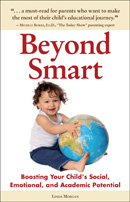 When ParentMap’s education expert Linda Morgan agreed to let us reprint part of her forthcoming book, Beyond Smart: Boosting Your Child’s Social, Emotional, and Academic Potential, we jumped at the chance. After all, Morgan — when she’s not raking in awards for journalistic excellence — spends her days covering the school scene, and has been for decades. No one knows learnin’ like our Linda.
When ParentMap’s education expert Linda Morgan agreed to let us reprint part of her forthcoming book, Beyond Smart: Boosting Your Child’s Social, Emotional, and Academic Potential, we jumped at the chance. After all, Morgan — when she’s not raking in awards for journalistic excellence — spends her days covering the school scene, and has been for decades. No one knows learnin’ like our Linda.
Still, picking just one topic? Not easy. In the end, we chose a pair of articles that tackle two of the most pressing educational issues parents face: how to improve math performance — in schools and at home — and how to keep tween girls from turning away from science. If these chapters leave you wanting more, visit Beyond Smart.
MAKING MATH MATTER
As parents, we value few skills more dearly than literacy. After all, reading opens the door to brand-new worlds, innovative ideas and critical thinking. Literacy holds the key to learning.
Who doesn’t revel in their child’s first recitation of the ABCs? What proud parents don’t crow — even a little bit — if their son or daughter turns out to be an early reader?
Funny, we never hear much about early adders. Or early subtractors, or even that occasional hyperprecocious kid who seems to intuitively recognize the relationship between integers. In fact, many of us, no math geniuses ourselves, laugh off our children’s computation struggles with a “Guess she’s just like me!” comment that translates into “It’s OK if you don’t do well in math.”
It turns out it’s not OK. A study published in 2008 by the U.S. Department of Education, “The Final Report of the National Mathematics Advisory Panel,” concludes that as a nation, our math skills are declining. “There are consequences to a weakening of American independence and leadership in mathematics, the natural sciences and engineering,” the study reports. “We risk our ability to adapt to change. We risk technological surprise to our economic viability — and to the foundations of our country’s security. National policy must ensure the healthy development of a domestic technical workforce of adequate scale with top-level skills.”
The picture’s even gloomier from a global perspective. Compared to math students around the world, our kids pretty much pale. Here’s what the 2009 National Report Card indicates (the data was collected by the National Assessment of Educational Progress): Thirty-four percent of students in the United States score at or above proficiency level in eighth-grade math, and 39 percent score at proficiency level in fourth-grade math. According to the National Mathematics Advisory Panel, just 23 percent — not even one out of four! — of U.S. students show math competency at grade 12.
What does all this, well, add up to? Seems that in this country, we don’t treat mathematics with enough respect, and our children feel the fallout. “Everyone is comfortable with reading,” says Becca Lewis, a former elementary-school teacher. “Parents have this expectation that all kids learn to read. But math is less visible. It’s harder to put in kids’ hands; you don’t have it sitting around your house, like books.”
Math counts
The reality is that math matters. “It can be a gatekeeper for a lot of kids,” says Lewis, who is now a curriculum designer at DreamBox Learning, a Web-based math-learning tool geared toward elementary-school kids. “If kids don’t take enough math or score well on tests, countless education and career opportunities will be unavailable to them.”
If your kids seem blasé about the education and job ops they risk missing, maybe they’ll respond to real-life requirements: Mundane tasks such as shopping, dining out, and figuring out mileage and budgets for trips all take numbers know-how.
“You don’t need to be math literate only if you want to become an astronaut,” says Sarah Daniels, a former Stanford math major who’s now marketing vice president for DreamBox. “You can’t buy a house, balance your checkbook, or decide whether it’s better to buy a product at Costco or the grocery store without math. But in our math-starved society, we’ve forgotten that.”
Teachers try their best to get students up to speed in math. But many teachers these days are undertrained and underfunded. “Teachers frequently lack things they need, like paper or ink, or hands-on materials kids can use to model their thinking,” says Lewis. And teacher-prep programs often go light on the math content. Lewis, who learned to teach kindergarten through eighth-grade math in a program that offered a semester-long weekly math/science course, supplemented her own training with additional instruction.
It doesn’t help that no one seems to agree on teaching methods. This, of course, is nothing new. Ever since “arithmetic” became “math” with the introduction of New Math in the Space Race ‘60s, coaching kids to multiply, divide and compute algebraic equations has generated controversy. For example: Is your child’s math program based on inquiry or does it focus on the basics? Ask around; the impassioned thinking and divergent views on this topic may surprise you.
“There has been a dumbing-down of content, standards and expectations in schools,” says Bob Brandt, a founding member of Where’s The Math?, an advocacy group that works to restore rigor to math education.
Where’s The Math? organizers call current math trends “fuzzy” and support a program that emphasizes fundamental computational skills. “If parents are technically trained, they look at their child’s math curriculum and think, ‘How will my child have the potential to do the kind of work I’m doing?’” says Brandt.
Bringing math home
While the math-ed hotshots battle it out, where does that leave parents and kids? With any luck, at home, engaging in number-rich games and activities.
No one is asking you to solve logic problems (second-graders can do them, but they make grownups dizzy) or do a fact triangle (don’t ask). Simply make counting, patterns and numbers part of your child’s routine.
Driving someplace? Notice which exit number is coming up — and show your child how they appear sequentially. If your child is a toddler, sing counting songs along the way, such as “One, Two, Buckle My Shoe.”
Read counting books to your youngster, such as Counting Crocodiles by Judy Sierra and Will Hillenbrand, Counting on Frank by Rod Clement, or My Little Counting Book by Roger Priddy. Then create your own counting book with your preschooler or kindergartener. Ask your child to draw four balls to illustrate the number four, and so on.
As kids get older, play board games with them that require math skills and score keeping, such as Yahtzee, checkers, and Chutes and Ladders.
“Add math to your child’s daily life in small ways, like a vitamin,” says Lewis. “That will help them think about math more positively.”
Excerpted from Beyond Smart: Boosting Your Child’s Social, Emotional, and Academic Potential by Linda Morgan, released March 2010 by ParentMap Books. For more information or to order, visit Beyond Smart.
How to make math matter
- Play number games during everyday activities, such as counting the number of steps, the number of items going into the laundry or the number of trucks you see while driving.
- Read the calendar and determine the number of days until an upcoming event. With older children, count by sevens.
- Plan a shopping list and figure out how to shop for items that fit your budget.
- With your young child, count the number of items you bought at the store.
- Read a recipe and have your child measure the amounts for the ingredients.
- Have your child practice counting the change needed to pay for an item.
- At the grocery store, ask your child to find items that are triangles, circles, rectangles and other shapes.
- Ask your child to recognize or stack the groceries you bought by container shape.
- Take measurements for a project around the house.
- Compare and organize tools, dishes or other objects based on size, color or weight.
Source: DreamBox Learning
KEEPING GIRLS INTERESTED IN SCIENCE
Not long after Mary Margaret Callahan took a physics exam at Whitman College in Walla Walla, Washington, in the late '90s, her professor said to the class: “Gentlemen, I am so embarrassed. Every girl scored higher than every boy in this class. But don’t worry, men, trend is not destiny.”
A few short years after that, Lawrence Summers, then president of Harvard University, told an academic conference that innate differences between men and women could be one reason fewer women succeed in math and science careers.
Ultimately, Summers (now head of the National Economic Council) resigned from his position, Callahan became a science and math specialist at the Seattle Girls School, and the rest of us were left to wonder once again just how far females really have come on the educational playing field.
Apparently, not far enough. “In certain science careers, such as computer engineering, women are sorely underrepresented,” says Stacey Roberts-Ohr, executive director of Expanding Your Horizons Network, a California-based organization that encourages young women to pursue careers in the fields of science, math and engineering. “We are trying to fix that.”
An advocacy group called the Math/Science Network says female membership in the National Academy of Sciences is just 10 percent — and the number of women earning doctorates in mathematics is declining. In addition, the National Center for Women and Information Technology found that while girls took 56 percent of all advanced placement (AP) tests in 2006, they made up just 15 percent of students taking the AP computer science test.
The math/science world hasn’t looked this dismal for girls since the first talking Barbie doll exclaimed, “Math class is tough!”
It’s not that young girls shun math and science. They do just fine — in fact, they often excel — until they hit middle school, according to Rafael del Castillo, a former science and math teacher who is now assistant head of the Seattle Girls School. “They lose confidence before they lose competence,” he says.
The reason? Girls tend to gather information collaboratively, he says. “They want to explore the process more and go a little deeper — to know the why and the how. Boys are more focused on the answer. They want to do it quickly and get it right.”
Teachers respond with enthusiasm to the male find-the-answer-fast learning model in math and science classes, del Castillo says. That turns the boys into the “good” students — the ones the teacher rewards — while the girls learn to see themselves as minor players. And that’s how self-confidence begins to ebb.
Without constructive experiences, girls won’t stay in science, says Nancy Ruzycki, Ph.D., a former University of Washington research scientist who teaches math and physics at Seattle’s Chief Sealth High School. Not that all Ruzycki’s own experiences have been constructive. Back in high school chemistry, she remembers, the teacher would shout “Beauty school!” if a female student spoke out of turn.
Finding role models
It doesn’t escape these educators and scientists that strong role models — women who have blazed trails in the math, science and tech worlds — have never achieved the visibility of, say, Hannah Montana. “There must be good images out there of creative, successful women,” says Callahan. “But what do girls see on TV? America’s top model? They need mentors.”
Chances are they won’t find them in elementary school. Grade-school teachers, usually generalists, are not highly trained in science, Ruzycki says. And most high school math and science departments are overwhelmingly male.
That leaves middle school, during which the social scene claims center stage. “Girls think, ‘Do I want boys to like me, or do I want to be the smart girl? Can I be a good student and be pretty and popular?’” says Callahan. “At that age, it’s hard for them to see themselves as a little of everything.”
They’re clearly not seeing themselves as computer scientists.
“The perception is that computer science is either a male field or a field for geeks,” says Mylene Padolina, senior diversity consultant for DigiGirlz High Technology Camps. Since 2000, Microsoft has sponsored DigiGirlz Camps, a summer camp for girls that introduces them to careers in the technology industry. The free camps are held throughout the country.
Technology, as Padolina points out, is not just a guy thing. “We want girls to understand there are lots of kinds of jobs in tech fields,” she says. “At Microsoft, there are programmers, developers and testers — but also psychologists, graphic artists and people in other disciplines.”
It’s a curious paradox that young women — more of them than ever — are training to become physicians. According to the Association of American Medical Colleges, the number of women applying to medical schools in the United States increases yearly; women now make up about 50 percent of all applicants.
Why do females sign up for bio class, but take a pass on engineering and physics? Less than 20 percent of doctorates in physics go to women, notes Ruzycki, who has one.
Everyone has a theory. Ruzycki feels it’s because medicine is generating a plethora of female role models. “Young women run into other women in biological and medical fields, and that makes a big difference,” she says. “Women in medicine can mentor other women and develop a work/life balance.”
Roberts-Ohr says women gravitate toward careers that help others. “In medicine, they feel they’re making a contribution,” she says. “They don’t see how computer science relates to the greater good. They think they’d be stuck behind a desk, programming all day.”
But before — way before — your daughter decides on a career in medicine or engineering or a stint at Microsoft, she needs to stay engaged in the math and science world. How can you help that happen?
Del Castillo is a big proponent of all-girls schools. “Parents need to look at their child and decide which kind of environment works best,” he says. “A single-sex option should be considered. If girls lose confidence or interest early, they will start down a different path.”
Excerpted from Beyond Smart: Boosting Your Child’s Social, Emotional, and Academic Potential by Linda Morgan, released March 2010 by ParentMap Books. For more information or to order, visit Beyond Smart.
How to keep girls interested in science
- Provide role models and mentors for your daughter in the math, science and tech worlds.
- Expose your daughter to the myriad jobs in these fields.
- Make sure you know what is going on in your daughter's science and math classrooms. Are teachers responding more to boys who go for the quick answers?
- If your daughter is beginning to lose interest in math or science, talk to the instructor and try to find out why.
- Look into summer science or technology camps for your daughter.
- Consider sending her to an all-girls school.











